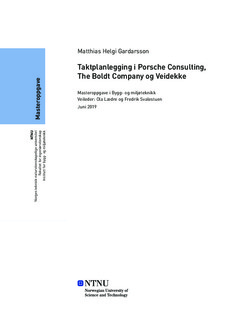| dc.description.abstract | Veidekke har de siste årene benyttet taktplanlegging i flere av sine prosjekter. Taktplanlegging er en ny metode i norsk byggebransje og Veidekke er en av få entreprenører som har brukt taktplanlegging i sine prosjekter. Resultatene har vært sprikende mellom prosjektene, til tross for at det har vært en viss kontinuitet i prosjektledelsen fra prosjekt til prosjekt. Samtidig har andre selskaper opplevd suksess med taktplanlegging. Det er derfor interessant å se på hva disse selskapene gjør annerledes enn Veidekke og hvilke erfaringer de har med metoden. Oppgaven kartlegger derfor ulike typer taktplanlegging, hvilke erfaringer det er gjort med disse metodene, og hvordan metoden kan forbedres. Forskningsspørsmålene som oppgaven besvarer er:
1. Hvilke metoder for takt finnes i dag?
2. Hva er erfaringene med disse metodene?
3. Hvordan kan metodene forbedres?
Masteroppgaven er et resultat av arbeid gjennom ett semester og tilsvarer 30 studiepoeng. Masteroppgaven bygger videre på forundersøkelser gjort i prosjektoppgave i 2018. Oppgaven tar for seg taktplanlegging i Porsche Consulting, The Boldt Company og Veidekke Entreprenør. Dette gjøres gjennom kvalitative forskningsmetoder og det er gjennomført litteraturstudie, dokumentstudie og intervjuer. Metodenes pålitelighet og er vektlagt og vurdert. Oppgaven er begrenset til å omhandle de tre nevnte bedriftenes metoder innen taktplanlegging, og oppgaven ser kun på innredningsfasen i byggeprosjekter. Det er ikke gjort egne målinger på prosjekter med taktplanlegging.
Metodene har blant annet til felles bruken av flere tog, involvering av underentreprenør underveis i produksjon, og hvilke typer buffere som benyttes. Metodene skiller seg blant annet fra hverandre ved involvering av underentreprenører i taktplanleggingen, kontrollområdeinndeling, takttid, typer prosjekter de bruker takt, samt hvilke faser de benytter metoden i. Det har også ulike prosedyrer for å gjenoppstarte takten ved stans i produksjonen.
Erfaringene for taktplanlegging er ømfintlig for avvik så det er viktig at det legges mye tid inn i planleggingen, at alle aktører følger takten og at avvik håndteres raskt. Ved å dele prosjektet inn i kontrollområder med klare overtagelses tidspunkter oppleves en mer stabil og transparent produksjon i tillegg til en mer ryddig arbeidsplass. Det finnes i dag begrenset litteratur om taktplanlegging så metoden er per nå påvirket av enkeltpersoner og bedrifter.
Oppgaven foreslår forbedringer knyttet til kontrollområdeinndeling, lengde på takttid og rutiner for gjenoppstart av takten ved stans. På samme tid som oppgaven ble skrevet så jobbet Veidekke med en veileder for taktplanlegging. Oppgaven kommer med flere punkter som Veidekke bør vurdere som en del av denne veilederen. | |
| dc.description.abstract | The contractor Veidekke has in recent years used takt time planning in some projects. Takt is a relatively novel method for the Norwegian construction industry, and Veidekke is one of few contractors that have applied it. The results of using takt have varied between the projects. Some projects have experienced success, and some have experienced failure-like outcomes. To some extent, the management staff and the foremen on-site have been the same across takt projects. At the same time other companies abroad have had success with the method. It is therefore interesting to see how takt is used by different companies internationally and which experiences these have compared to Veidekke. Based on that, there is a need to find out how using takt in construction can lead to success. Therefore, this study maps experiences with takt in Norway and abroad. The research questions:
• What types of takt are used today?
• What are the experiences with takt?
• How can the method improve?
The study’s novel contribution lies in the comparison of how takt is practiced in by the companies Porsche Consulting, The Boldt Company and Veidekke. Veidekke has cooperated with both Boldt and Porsche Consulting, so their use of takt is known in by Veidekke employees. The paper mainly takes interior work into consideration, even though it’s also used for concrete and exterior work.
The Master's thesis is a result of work through one semester and corresponds to 30 credits. The thesis builds on preliminary studies done in a project assignment in 2018. The thesis deals with takt time planning in Porsche Consulting, The Boldt Company and Veidekke Entreprenør. This is done through qualitative research methods. Literature study, document studies and interviews have been conducted. The task is limited to addressing the three aforementioned companies' methods in takt time planning, and the task only looks at the interior design phase of construction projects. No separate measurements have been made on projects in this thesis.
The methods have, among other things, in common the use of several trains in their projects, the involvement of subcontractors during production, and the types of buffers used. The methods differ from each other in the way the involvement of subcontractors in the planning, division of zoning, takt time, types of projects they implement takt time planning on, as well as the phases of the projects in which they use the method.
Experience show that the method is sensitive to deviations from the plan so it is important to develop a simple plan that everyone can agree upon. It’s also important that all actors follow the work pace and that deviations are handled quickly. By dividing the project into zones with clear schedule for handovers, a more stable and transparent production, in addition to a tidier workplace. There is currently limited literature on timetable planning, so the method is currently influenced by individuals and businesses.
The thesis proposes improvements related zoning, length of takt time and routines for restarting the pace in case of unplanned halts in production. At the same time as the task was written, Veidekke worked with a guideline for timetable planning. The thesis comes with several points that Veidekke should consider to be part of this guideline. | |
